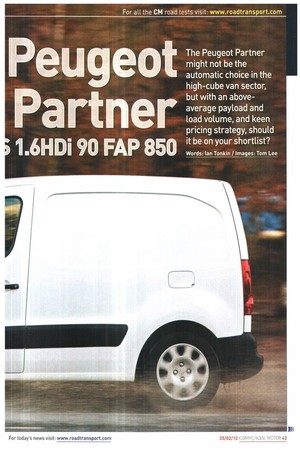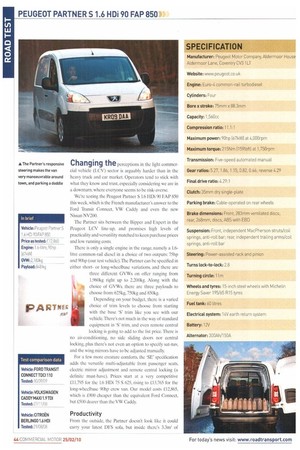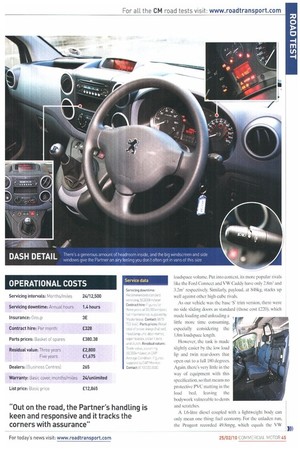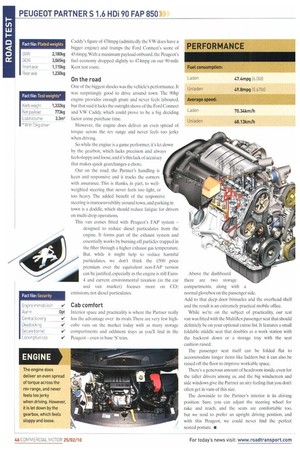Peugeot Partner
Page 43

Page 44

Page 45

Page 46

If you've noticed an error in this article please click here to report it so we can fix it.
1.6HDi 90 FAP 850
The Peugeot Partner might not be the automatic choice in the high-cube van sector, but with an aboveaverage payload and load volume, and keen pricing strategy, should it be on your shortlist?
Words: Ian Tonkin / Images: Tom Lee
Changing the perceptions in the light commercial vehicle (LCV) sector is arguably harder than in the heavy truck and car market. Operators tend to stick with what they know and trust, especially considering we are in a downturn, where everyone seems to be risk-averse.
We're testing the Peugeot Partner S 1.6 HDi 90 FAP 850 this week, which is the French manufacturer's answer to the Ford Transit Connect, VW Caddy and even the new Nissan NV200.
The Partner sits between the Flipper and Expert in the Peugeot LCV line-up, and promises high levels of practicality and versatility matched to keen purchase prices and low running costs.
There is only a single engine in the range, namely a 1.6litre common-rail diesel in a choice of two outputs: 75hp and 90hp (our test vehicle). The Partner can he specified in either shortor long-wheelbase variations, and there arc three different GVWs on offer ranging from 1.960kg right up to 2,200kg. Along with the choice of GVWs. there are three payloads to choose from: 625 kg, 750kg and 850kg.
Depending on your budget, there is a varied choice of trim levels to choose from starting with the base '8' trim like you see with our vehicle. There's not much in the way of standard equipment in '5' trim, and even remote central locking is going to add to the list price. There is no air-conditioning, no side sliding doors nor central locking, plus there's not even an option to specify sat-nay, and the wing mirrors have to be adjusted manually.
For a few more creature comforts, the 'SE' specification adds the versatile multi-adjustable front passenger seats, electric mirror adjustment and remote central locking (a definite must-have). Prices start at a very competitive £11,795 for the 1.6 HDi 75 S 625, rising to £13,765 for the long-wheelbase 90hp crew van. Our model costs £12,865, which is £900 cheaper than the equivalent Ford Connect, but £500 dearer than the VW Caddy.
loadspace volume. Put into context, its more popular rivals like the Ford Connect and VW Caddy have only 2.8m' and 3.2m3 respectively. Similarly, payload, at 848kg, stacks up well against other high-cube rivals.
As our vehicle was the base S' trim version, there were no side sliding doors as standard (those cost 1220), which made loading and unloading a little more time consuming, especially considering the 1.8m loadspace length.
However, the task is made slightly easier by the low load lip and twin rear-doors that open out to a full 180 degrees. Again. there's very little in the way of equipment with this specification, so that means no protective PVC matting in the load bed, leaving the bodywork vulnerable to dents and scratches.
Caddy's figure of 478mpg (admittedly the VW does have a bigger engine) and trumps the Ford Connect's score of 45.6mpg.With a maximum payload onboard. the Peugeot's fuel economy dropped slightly to 474mpg on our 90-mile Kent test route.
On the road
One of the biggest shocks was the vehicle's performance. It was surprisingly good to drive around town. The 90hp engine provides enough grunt and never feels laboured, but that said it lacks the outright shove of the Ford Connect and VW Caddy, which could prove to be a big deciding factor come purchase time.
However, the engine does deliver an even spread of torque across the rev range and never feels too jerky when driving.
So while the engine is a game performer. it's let down by the gearbox, which lacks precision and always feels sloppy and loose, and it's this lack of accuracy that makes quick gearchanges a chore.
Out on the road. the Partner's handling is keen and responsive and it tracks the corners with assurance. This is thanks, in part, to wellweighted steering that never feels too light, or too heavy. The added benefit of the responsive steering is manoeuvrability around town, and parking in town is a doddle, which should reduce fatigue for drivers on multi-drop operations.
This van comes fitted with Peugeot's FAP system — designed to reduce diesel particulates from the engine. It forms part of the exhaust system and essentially works by burning off particles trapped in the filter through a higher exhaust gas temperature. But, while it might help to reduce harmful particulates, we don't think the £500 price premium over the equivalent non-FAP version can be justified, especially as the engine is still Euro4 and current environmental taxation (in the car and van market) focuses more on CO2 emissions, not diesel particulates.
Cab comfort
Interior space and practicality is where the Partner really has the advantage over its rivals. There are very few highcube vans on the market today with as many storage compartments and oddment trays as you'll find in the Peugeot — even in base 'S' trim. Above the dashboard there are two storage compartments, along with a normal glovebox on the passenger side.
Add to that deep door binnacles and the overhead shelf and the result is an extremely practical mobile office.
While we're on the subject of practicality, our test van was fitted with the Multiflex passenger seat that should definitely be on your optional extras list. It features a small foldable middle seat that doubles as a work station with the backrest down or a storage tray with the seat cushion raised.
The passenger seat itself can be folded flat to accommodate longer items like ladders hut it can also be raised off the floor to improve workable space.
There's a generous amount of headroom inside, even for the taller drivers among us, and the big windscreen and side windows give the Partner an airy feeling that you don't often get in vans of this size.
The downside to the Partner's interior is its driving position. Sure, you can adjust the steering wheel for rake and reach, and the seats are comfortable too, but we tend to prefer an upright driving position, and with this Peugeot, we could never find the perfect seated posture.




































































































































